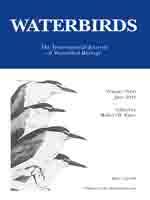Point-count surveys of Black Terns (Chlidonias niger surinamensis) were conducted in Wisconsin from 1980 to 2011 to assess statewide population trends of this declining species. The survey program consisted of 19 roadside transects, each with 15 stops (N = 285 stops total), spread across 15 counties throughout the state. Surveys were conducted at the same sites each year during three periods (1980–1982, 1995–1997, 2009–2011) by observers who visited each site once during the breeding season (25 May to 24 June) and counted the number of Black Terns seen during a 5-min interval. Over the three survey periods, statistically significant changes in abundance occurred on 14 of the 19 transects, most of which either were linear or exponential declines; no significant increases were evident. Survey-wide, the population declined in abundance by nearly 70% over the past 30 years and site occupancy declined by a similar percentage. Complete extirpation was recorded on four transects. Nest counts in two intensive study areas were consistent with the declining trend indicated by the point-count surveys. Likely causes of the decline include continued loss and degradation of breeding habitat and low annual adult survival probability, the latter for which reasons currently are unknown. Protection of remaining breeding colonies and restoration of degraded wetlands are recommended conservation measures for this species in Wisconsin and elsewhere.
How to translate text using browser tools
1 June 2012
Population Decline of Black Terns in Wisconsin: A 30-Year Perspective
Sumner W. Matteson,
Michael J. Mossman,
David A. Shealer

Waterbirds
Vol. 35 • No. 2
June 2012
Vol. 35 • No. 2
June 2012
Black Tern
Chlidonias niger surinamensis
distribution
population trend
survey counts
wetland birds
Wisconsin




